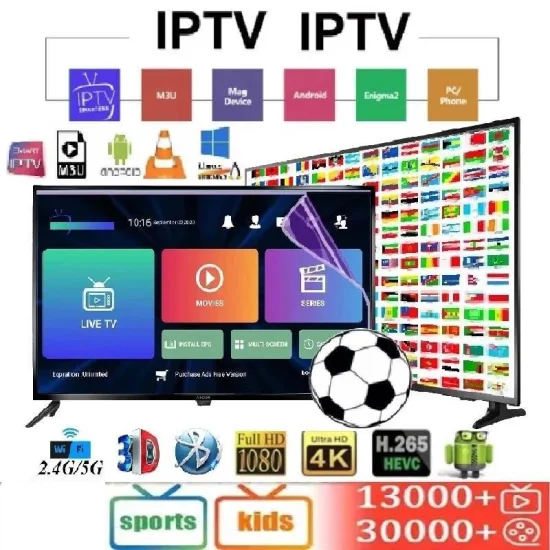How IPTV Works: A Step-by-Step Overview to Net Protocol Television Technology
Net Method Television (IPTV) has reinvented the method we eat tv material, supplying a new realm of opportunities through the power of the net. Understanding the details of how IPTV functions can clarify the technology that drives this ingenious type of media distribution. From the fundamental principles of IPTV to the complex process of material shipment, each action plays an essential function in making sure a seamless viewing experience. In this overview, we will certainly reveal the hidden mechanisms that make IPTV an interesting fusion of technology and enjoyment.
IPTV Basics
In comprehending IPTV fundamentals, it is critical to realize the fundamental functions of this innovation in delivering tv content online. IPTV, which means Net Method Tv, uses Web Protocol (IP) networks to send television web content to users' gadgets. Unlike traditional methods of relaying television web content through cord or satellite signals, IPTV streams media with high-speed internet links.

Additionally, IPTV permits for interactive capabilities, such as video clip as needed (VOD) and digital program guides (EPG), boosting the customer experience by supplying even more control and flexibility in accessing material. Generally, understanding the fundamentals of IPTV sets the foundation for discovering its advanced capabilities and the benefits it uses to modern tv consumption.
Content Distribution Process
Effective web content distribution in IPTV systems involves a well-structured procedure that guarantees smooth transmission of television content over IP networks. The web content distribution procedure in IPTV begins with the creation of the video material, which is then inscribed into digital layout appropriate for IP transmission.

Middleware Capability
With the integration of middleware, IPTV systems gain improved capability that streamlines customer interaction and content monitoring. Middleware functions as a crucial component that connects the void between the interface and the back-end facilities, promoting seamless communication and communication within the IPTV system. Among the essential features of middleware in IPTV is to allow tailored individual experiences by offering attributes such as interactive program overviews, video-on-demand services, interactive advertising and marketing, and individual choices monitoring. By systematizing these capabilities through middleware, company can use a more dynamic and customized IPTV experience to their clients.

Tool Compatibility
Provided the critical duty of middleware in allowing smooth communication and web content management in IPTV systems, a crucial element to consider is the compatibility of tools used for accessing the IPTV solutions. Device compatibility is essential for making certain a smooth individual look at this web-site experience and optimum efficiency when accessing IPTV web content.
In the context of IPTV, device compatibility refers to the ability of a tool to efficiently connect with the IPTV solution, present material correctly, and sustain the necessary methods and codecs for streaming video web content over the net. Various gadgets, such as wise TVs, set-top boxes, mobile phones, tablets, and computer systems, might have varying degrees of compatibility with IPTV solutions.
To make certain a smooth watching experience, it is necessary for users to choose gadgets that are compatible with the specific IPTV service they are using. In addition, IPTV provider must offer assistance for a large variety of tools to accommodate the varied requirements of their individual base. By focusing on gadget compatibility, both individuals and company can boost the general IPTV experience.
Quality of Service (QoS)
Considering the essential function of preserving a high requirement of efficiency and integrity in IPTV systems, making sure consistent Top quality of Solution (QoS) continues to be a fundamental aspect of the customer experience. QoS in IPTV describes the ability of the system to provide web content with marginal disturbances, high resolution, and quick packing times. To accomplish ideal QoS, different elements need to be addressed. view Network bandwidth is essential to sustain top notch video clip streaming without buffering or pixelation. Additionally, latency, jitter, and package loss must be reduced to improve the watching experience.
Solution suppliers utilize QoS systems such as traffic prioritization, buffering, and error modification to maintain a secure IPTV solution. By focusing on IPTV web traffic over much less time-sensitive data, carriers can make certain smooth playback also throughout top use hours. Buffering aids make up for network changes, while error adjustment methods enhance information honesty.
Constant surveillance and optimization of QoS criteria are important to adjust to changing network problems and individual demands. Eventually, a robust QoS framework is important for delivering a smooth and delightful IPTV experience to customers.
Final Thought
In conclusion, IPTV runs via the transmission of tv material over net method networks. The technology entails an organized process of content delivery, promoted by middleware performance to make certain compatibility across various gadgets. High quality of Solution plays a vital function in maintaining the efficiency and reliability of IPTV solutions. Comprehending the fundamental concepts of IPTV is important for realizing the complexities of this ingenious television modern technology.